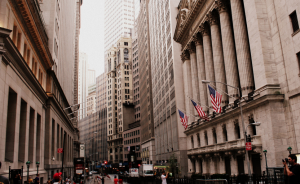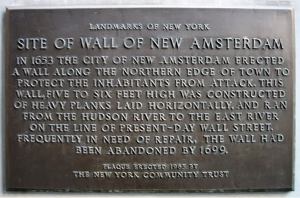For our Dutch artifact we chose Wall Street. It is located in Manhattan, New York and we picked this because of its historical significance as a part of New York City (formerly New Amsterdam) and its relevance in our society as a dominating topic in political, economic, and social discourse. Wall Street, as it has grown into the financial and business center of the global economy, has taken on an identity that many Americans associate with wealth and power. However, many people today view Wall Street in a negative light because of the involvement of the banks and financial organizations in the recent financial meltdown along with the nefarious and speculative practices that have occurred.
Wall Street dates back to the Dutch colonial times in Manhattan. The name of this renowned street actually comes from the wall of the Dutch settlement because “in the 17th century the wall formed the northern boundary of the New Amsterdam settlement erected for defensive purposes,” (http://www.loc.gov/rr/business/wallstreet/wallstreet.html). Protection was important to the settlers as a potential war was threatening to erupt between the English and the Dutch. The wall was built around the year 1685 by the Dutch settlers, led by Peter Stuyvesant and the Dutch West India Company. Wall Street tells the story of the earliest Dutch settlers in Manhattan, and how they were innovative in the actual construction of the wall. Interestingly, Wall Street also created a natural split of socioeconomic classes as well. Local merchants of New Amsterdam became split into two groups: auctioneers and dealers. Also, Wall Street was a popular place where slave owners were able to rent out their slaves by the day, week, or month. Overall, the early economic innovation of Wall Street created by the Dutch shows how Wall Street, has been a major center for economic activity for many centuries. Now, Wall Street is the busiest financial area in the entire world. This relates to the history of how the Dutch settlers made this area extremely busy and lively back in the 1600s. While Wall Street is not directly connected to Rutgers, it has become an incredibly popular area for college graduates to seek employment and Rutgers sends many graduates and alumni to this historic financial center.


Bibliography
http://www.loc.gov/rr/business/wallstreet/wallstreet.html
http://www.newnetherlandinstitute.org/history-and-heritage/digital-exhibitions/a-tour-of-new-netherland/manhattan/wall-street/
http://www.wsj.com/articles/trading-the-suburbs-for-high-rise-living-in-amsterdam-1452704582
http://www.aviewoncities.com/nyc/wallstreet.htm
http://www.wsj.com/articles/a-long-weekend-getaway-to-amsterdam-1433530832
